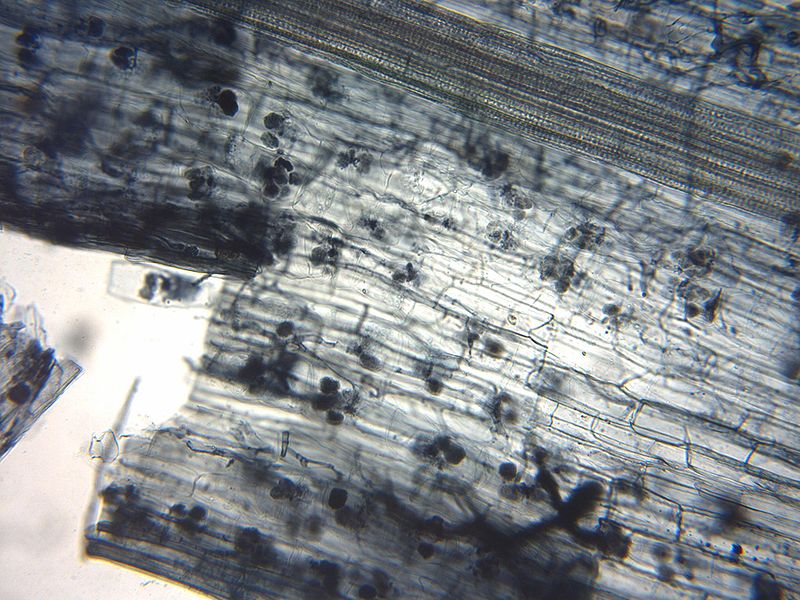Aphid attacks should be reported through the fungusphone
We like to think of ourselves as the better results of evolution. We humans are particularly proud of our ability to communicate, having invented cell phones, the Internet, and extended forelimb digits as sophisticated means of communication not found anywhere else in nature.
Not true. Where there is life, there is communication. Vocal, visual, chemical. Some fish even communicate electrically. Take, that, Alex G. Bell! From bacteria to Blue Whales, from yeast to yak, everyone communicates. Including plants.
When some plants are attacked by sap-sucking aphids, they emit volatile compounds into the air. These volatiles serve as a defense mechanism, and in more ways than one. First, they serve to repel the aphids attacking the plant. Second, they attract the aphids natural enemies, wasps. But there’s more to that: a team from the University of Aberdeen and the James Hutton Institute show that some plants use fungi to communicate the presence of aphids, allowing those plants to emit wasp-attracting and and aphid-repelling volatiles even before they have been physically attacked.

Pea Aphids. Source: PLoS Biology, 2/2010. Credit: Shipher Wu (photograph) and Gee-way Lin. National Taiwan University.
Introducing the arbuscular mycorrhyza (AM) fungus, which has been living symbiotically with plants for at least 460 million years. The AM fungi and their symbiotic plants create mycorrhiza, structures in which the fungus penetrates the plant’s root cells forming arbuscules, branched structures interfacing within the plant cells. The arbuscules allow the exchange of nutrients between plant and fungus. The result allows plants to capture nutrients such as phosphate, zinc and nitrogen. AM fungi are found in 80% of vascular plant families (plants which transport nutrients and water via a vascular system), which makes them an essential part of plant life. While we think of fungi mostly as mushrooms, those are only the fruiting bodies of the fungi. Like all fungi, the major biomass of AM lies in the mycelium: a network long, thin filamentous structures that branch within the soil where they grow. The hypothesis that the researchers tested was: are the AM fungus mycelia used to communicate information between plants, in a sort of symbiotic nervous system?

Flax root cortical cells containing paired arbuscules. Credit: MS Turmel, University of Manitoba. Source: wikipedia
To answer this question, they planted bean seedlings in a pot whose soil contains an AM fungus. They isolated some seedlings from the AM fungus using a fine mesh, while others had only their roots isolated, or were not isolated at all. All plants were covered individually with bags to ensure they do not communicate via the air using volatiles. Then the researchers infested one plant with aphids, and collected the volatiles from the other plants. They discovered that the plants connected by the fungal network produced volatiles that repelled aphids and attracted wasps. Those plants which had no hyphal contact produced much less of these volatiles. In the control, the plants in the fine mesh that had hyphal contact only, but no root contact, also produced anti-aphid volatiles.
Bottom line: plants can communicate via fungal networks, although we don’t quite know how yet. Also, probably this is not an exclusive mode of communication. Apparently, symbiosis is not just about food or protection from predators or the elements. It’s also about conveying information. Very cool.
![]()
Zdenka Babikova, Lucy Gilbert, Toby J. A. Bruce, Michael Birkett, John C. Caulfield, Christine Woodcock, John A. Pickett, & David Johnson (2013). Underground signals carried through common mycelial networks warn neighbouring plants of aphid attack Ecology Letters, 16 (7), 835-843 DOI: 10.1111/ele.12115



















Really cool story and great post, thanks!
is fungi a medium that can be used to transfer information?
[…] Pants use Fungus to Communicate? […]
[…] “除了人类之外,动物如鱼类和植物都能利用工具通信,而植物的通信工具甚至有可能是活的。当遭到蚜虫攻击,某些植物会释放出易挥发性化合物吸引蚜虫天敌黄蜂,帮助消灭蚜虫。根据发表在《Ecology Letters》上的一项研究,阿伯丁大学研究人员发现,受到蚜虫入侵的植物会通知附近植物蚜虫到来,而其通信工具是土壤中真菌构建的网络。真菌与植物共生,除了提供养分它们还充当通信硬件。” […]
[…] http://bytesizebio.net/index.php/2013/08/03/aphid-attacks-should-be-reported-through-the-fungusphone… […]
[…] Aphid attacks should be reported through the fungusphone | Byte Size Biology. […]
[…] enemies. Researchers at the University of Aberdeen have shown that plants attacked by aphids can communicate that information to neighboring plants via existing networks of fungi in the soil. Thus fungal symbiosis with plants is shown to be taken one step further: not only do they provide […]
[…] Fuente: Byte Size Biology […]
Awesome story, but what is with that animated tag cloud on the right navigator. Wasting of CPU/energy/battery aside, it’s pretty much impossible to use.
I read an article by Paul Stamets on the mycelial woodland network, and in fact it was Paul Stamets’ Facebook post that led me to this article. Extremely interesting how naively reductive general knowledge is about plants and fungus.
Oh boys and girls, another little tidbit for me to put on the fungal net of fb, etc.
[…] http://bytesizebio.net/index.php/2013/08/03/aphid-attacks-should-be-reported-through-the-fungusphone… […]
[…] Aphid attacks should be reported through the fungusphone (bytesizebio.net) […]
[…] Continuing on in that, we see animals as more valuable than plants, fungi, and the like. Someone who would never dream of killing an animal will happily uproot carrots and prune a bonsai tree into perpetual tininess. The usual justification is that since plants don’t have nervous systems like animals do, they don’t feel pain and therefore it’s okay to do whatever you want to them. This is even in spite of new research showing that plants can communicate with each other through sound, chemicals and even the mycelial mat of fungi connecting their roots. […]